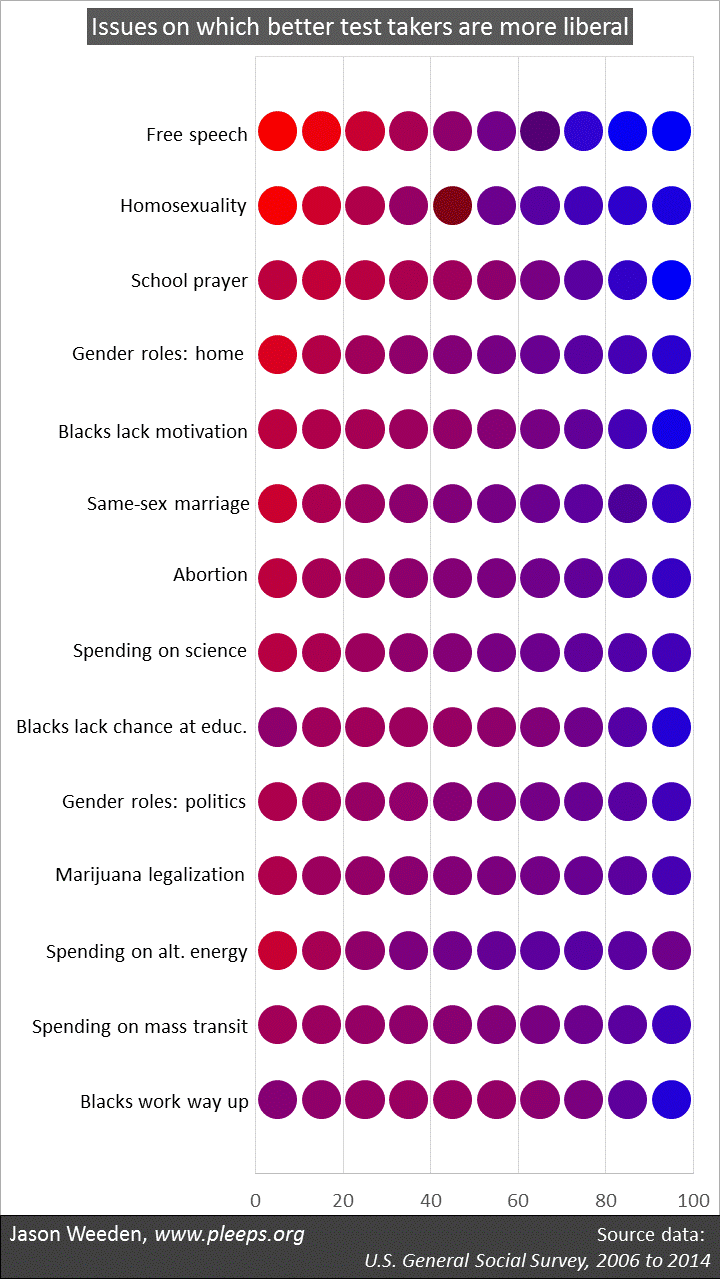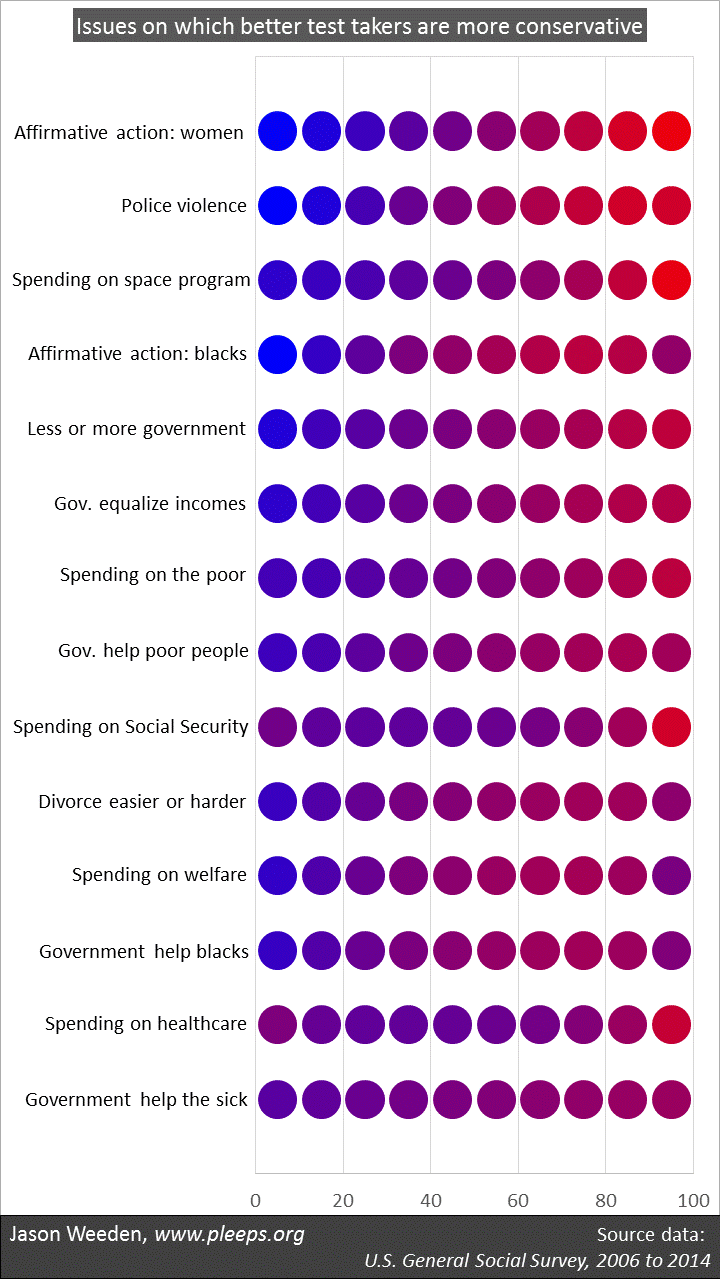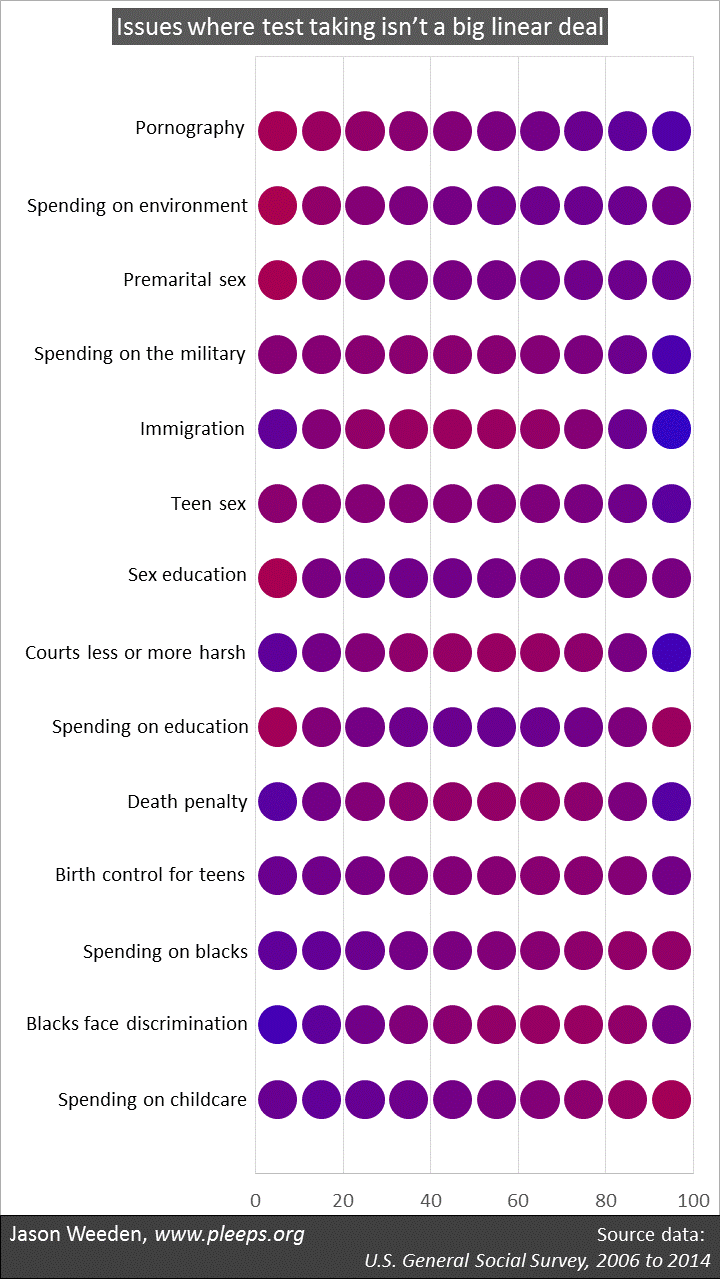Should we increase taxes on the wealthy and use that money to give more help to the poor? Should we increase efforts to deport undocumented immigrants? Because of past discrimination, should businesses make special efforts to hire and promote blacks? Should abortion generally be legal? Should we allow teacher-led prayer in public schools?
There are many demographic differences in public opinion on these kinds of questions—differences related to race, religion, income, gender, and so on. And a lot of them aren’t very hard to understand. For example, poor people and minorities are much more likely than whites with higher incomes to favor increased income redistribution. Native-born folks are much more likely than immigrants to think that immigration is a burden on the country. Blacks are much more likely than whites to think that the country needs to make further changes to address racial discrimination. People who sleep around a lot and have fewer children are much more likely than monogamous, high-fertility types to think that abortion should be legal. Christians are much more likely than non-Christians to favor school prayer.
Another demographic factor that matters involves how well people do on tests. Sometimes surveys give people political knowledge tests, vocabulary tests, basic science tests, and so on. And it turns out that, on various kinds of political issues, good and bad test takers differ on average.
I’ll argue later in this post that—like differences related to race, religion, and so on—the political differences between good and bad test takers also often aren’t very hard to understand. But to see the patterns with test taking, there are hurdles to be cleared. Most politically engaged people are invested in the ideas (1) that there are correct answers to questions of political values and (2) that the people on one’s own political side are basically by definition smarter because they recognize these correct answers. Thus, unlike differences based on income or gender or whatever, people often really want and expect that the better test takers will favor their own political side. In contrast, I’ll suggest a different way to think about it.
But first let’s see what the political differences actually are.
The issue positions of good and bad test takers
The U.S. General Social Survey (GSS) often gives a 10-item multiple-choice vocabulary test. It also recently often includes a set of basic science questions—for example, true or false: The center of the Earth is very hot; All radioactivity is man-made; It is the father’s gene that decides whether the baby is a boy or a girl; Lasers work by focusing sound waves; Electrons are smaller than atoms. I chose a set of 10 of these science items, all of which are entirely non-political (that is, I did not include anything on evolution, global warming, etc.).
In the GSS waves from 2006 to 2014, there were over 3,400 people who were given both the 10-item vocabulary test and the 10-item science test. I’m using this portion of the sample that was given all 20 items—that’s the “test” when I’m talking about “test takers.” These folks were also asked various political issue opinions (some of the political items were asked to all of them and others to only a subset, though every political item I’m looking at was asked to at least 1,300 test takers).
Now, what are the issue differences relating to test performance? I’ve split it up into three charts. The first one below shows issues on which good test takers are more liberal than bad test takers. Rather than showing a bunch of numbers, I’m just using colored circles for various percentiles of test performance from the 5th to the 95th. Red circles indicate conservative averages, blue circles indicate liberal averages, and various shades of reddish and blueish purple are in between.
So, the first line on the first chart involves free speech issues—these are items where respondents are asked whether various unpopular groups should be allowed to give public speeches, have their books in libraries, and teach at public colleges. Here, those with good test performance are much more likely than those with poor test performance to say “yes.”
In addition, the good test takers are more likely than bad test takers to: find no moral issue with homosexuality, favor a ban on school prayer, disagree that traditional gender roles at home are generally best, disagree that blacks lack motivation, favor the legality of same-sex marriage, favor the legality of abortion, favor more government spending on science, agree that blacks lack an equal chance at education, disagree that men are better suited for politics than women, favor the legality of marijuana, favor more government spending on alternative energy, favor more government spending on mass transit, and disagree that blacks should be expected to work their way up without assistance like various white immigrant groups have.
The next chart shows issues on which good test takers are more conservative than bad test takers. Here, the good test takers are more likely than bad test takers to: disagree that businesses should make special efforts to hire and promote women, agree that police are sometimes justified in hitting adult males, favor more government spending on the space program, disagree that businesses should make special efforts to hire and promote blacks, want less government overall, think that the government should not concern itself with reducing income differences between the rich and the poor, disfavor higher government spending on or more help for the poor, disfavor higher government spending on Social Security, think divorces should be harder to get, disfavor higher government spending on welfare, disfavor government help for blacks, and disfavor higher government spending on or more help with healthcare.
And, lastly, the third chart below shows the issues that don’t have a big linear relationship with test performance—that is, the good test takers don’t differ very much from the bad test takers (though, in some cases, the good and bad test takers differ meaningfully from the middle-of-the-road folks; more on that in a bit). These issues involve: whether pornography should be legal, whether there should be more government spending on the environment, whether premarital sex is morally acceptable, whether there should be more government spending on the military, whether immigration levels should be reduced, whether premarital sex between teens is morally acceptable, whether public schools should include sex education, whether courts should be more or less harsh, whether there should be more government spending on education, whether the death penalty should be used, whether birth control should be available to teens without parental consent, whether there should be more government spending on blacks, whether the main cause of racial disparities is discrimination, and whether there should be more government spending on childcare.
As I mentioned, some of the issues show non-linear patterns—typically where both the best and worst test takers are more liberal than folks in the middle. Most of these issues relate (directly or indirectly) to race. So, on the last chart, take a look at the responses on immigration, how harsh courts should be, the death penalty, and whether blacks face discrimination. Similarly, on the second chart, this non-linear pattern shows up on affirmative action for blacks, spending on welfare, and government help for blacks. On the first chart, it peeks through on whether blacks lack a chance at education and whether blacks should be expected to work their own way up.
Are the best test takers liberal or conservative? Both/neither/it depends.
If we focus on the very high end (the 95th percentile), within the issue set I looked at, here are the 15 positions they are most unusually likely to hold relative to the rest of the public: (1) people from unpopular groups should nonetheless have the right to make speeches, teach, and have books in libraries; (2) the existing ban on school prayer should continue; (3) women should not get workplace affirmative action; (4) black achievement isn’t being held back by a lack of motivation; (5) government spending for space exploration should be increased (or at least not reduced); (6) homosexuality isn’t wrong; (7) blacks should not be expected to overcome prejudice and work their own way up like white immigrant groups have; (8) black achievement is being held back by a lack of educational opportunity; (9) Social Security spending should be reduced (or at least not increased); (10) traditional gender roles in the home aren’t generally best; (11) police are sometimes justified in hitting adult males; (12) immigration levels should be increased (or at least not reduced); (13) government healthcare spending should be reduced (or at least not increased); (14) abortion should be legal; (15) same-sex marriage should be legal.
Some of these positions are more typical of people who call themselves “liberal” (1, 2, 4, 6, 7, 8, 10, 12, 14, and 15) while some are more typical of people who call themselves “conservative” (3, 5, 9, 11, and 13). Really, though, the positions are most consistent with what is usually thought of as libertarian, which is a key reason why some libertarians favor epistocracy proposals that allocate more voting power to better test takers. Some issues don’t fit the pattern, though. For example, high-end test takers are more likely than others to favor the Supreme Court’s ban on school prayer and to favor higher government spending on the space program—positions not usually associated with libertarians.
And it’s really not that the best test takers are liberal on “social” issues but conservative on “economic” ones. On social issues, for instance, these folks tend to oppose traditionally discriminatory stuff (e.g., they don’t like school prayer, they don’t endorse stereotypical gender roles, they’re accepting of immigrants and homosexuals, and they see a lack of educational opportunity rather than a lack of motivation as more important to racial disparities) but they tend not to want workplace affirmative action. On economic issues, while they’re stingier than others with government money when it comes to Social Security, healthcare, and the poor, they’re actually more likely than others to favor government money for science, alternative energy, and mass transit.
A matter of interests
At this point, libertarian readers are likely to be high-fiving themselves, while liberal and conservative readers are likely to be coming up with a series of “yeah, but” objections (or, really, many have probably already clicked away). Both reactions, I think, come from the same set of shaky premises. Basically, they both assume that to say “the best test takers generally want political position X to prevail” somehow implies “political position X is something everyone ought to want to prevail”—as though political values present straightforward factual questions that have universally correct answers.
Kurzban and I proposed a different way to think about it. We focused on interests—whether different political outcomes help or hurt one’s self along with one’s family and social network. From this perspective, lots of demographic differences in political positions come into greater focus. It helps explain why poor folks and minorities tend to be a lot more liberal than wealthier whites on government safety nets. It helps explain why racial minorities are most opposed to racial discrimination, religious minorities are most opposed to religious discrimination, LGBT folks are most opposed to discrimination against LGBT folks, immigrants are most opposed to discrimination against immigrants, and so on. It helps explain why churchgoers are so much more conservative on sexual and reproductive lifestyle issues (abortion, pornography, marijuana, etc.), taking into account that people tend to adjust their level of religious attendance to match their own lifestyles.
And it helps make sense of the various patterns involving test-taking performance. Most obviously, good test takers really tend to like meritocracy—that is, they tend to want social advantages to be allocated based on test-taking ability and educational pedigree rather than based on the old divisions of race, religion, gender, and so on. From an interest-based perspective, it’s just not surprising that better test-taking performance correlates with wanting an open marketplace of ideas, with opposing the old barriers to meritocratic success, and so on. It also helps explain their relative opposition to workplace affirmative action—good test takers aren’t defending liberal positions here, but rather meritocratic ones, which involve opposing both disadvantages and advantages that are based on the old group-based criteria. And it helps explain why, when diagnosing the causes of racial inequality, they see it not as hopeless character defects but rather as a lack of educational opportunities.
And it goes the other way as well. If they’re adopting positions in their interests, don’t expect bad test takers to agree that social advantages should mostly come down to test-taking ability and related educational matters. Expect them to seek advantages where they can find them, including in ways meritocrats find deplorable.
While the primary effect of test-taking performance is on issues relating to meritocracy vs. discrimination, there are secondary themes as well. Good test takers tend to wait longer to have kids—and they’re more liberal on abortion. Good test takers tend to be wealthier—and they have stingier views on government spending on the poor. Good test takers are more likely to work in brainy fields—and they have more generous views on government spending on scientific pursuits.
It’s not that these kinds of interests explain everything or are the single most important factor in public opinion. Yet these concrete interests are in the mix of big-deal factors.
Lots of the political outcomes that good test takers want are the sorts of outcomes that would disproportionately benefit good test takers. On many of these issues, it actually wouldn’t be very smart for bad test takers to agree with them.



